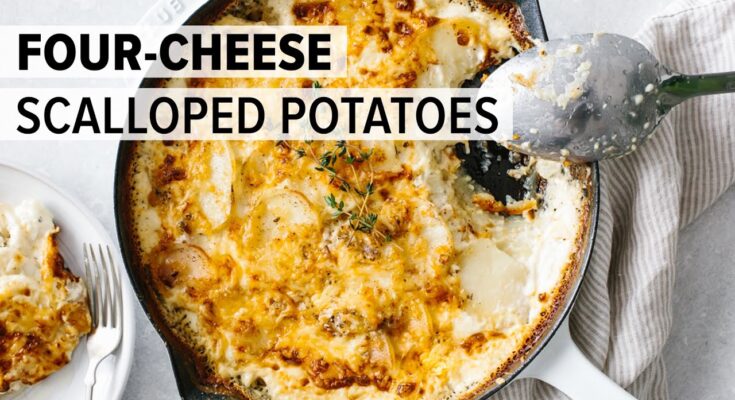Best Scalloped Potatoes Recipe: Scalloped potatoes are the ultimate comfort food—creamy, cheesy, and irresistibly satisfying. If you’re a fan of rich, oven-baked dishes that make your house smell amazing, then you’re in for a treat. This dish, which layers thinly sliced potatoes with a luscious cream sauce, is perfect for holidays, family dinners, or just a cozy weekend meal. But here’s the thing—getting scalloped potatoes just right isn’t always easy. You need the right potatoes, the perfect sauce, and a few kitchen tricks to bring it all together.
The good news? We’ve got you covered. This is your ultimate step-by-step guide to creating the best scalloped potatoes you’ve ever had. Whether you’re a seasoned home cook or a beginner, this recipe breaks it all down into manageable steps. So, grab your apron—it’s time to dive into a creamy, dreamy, golden-baked dish that’ll have everyone asking for seconds.
Ingredients You’ll Need
The beauty of scalloped potatoes is in their simplicity. Just a few core ingredients come together to make something truly special. Here’s what you’ll need to get started:
Basic Ingredients:
- Potatoes – 2.5 to 3 pounds of Russet or Yukon Gold
- Butter – 4 tablespoons (unsalted)
- Garlic – 2 cloves, minced (optional but recommended)
- All-purpose flour – 3 tablespoons (to thicken the sauce)
- Milk – 2 cups (whole milk preferred)
- Heavy cream – 1 cup for richness
- Salt and black pepper – to taste
- Nutmeg – just a pinch (adds a warm, nutty flavor)
- Shredded cheese – 1 to 1.5 cups (cheddar, gruyère, or a mix)
Optional Add-ons for Extra Flavor:
- Cooked bacon bits – Adds a smoky depth
- Fresh thyme or rosemary – Infuses earthy aroma
- Parmesan cheese – Adds a sharp and salty finish on top
- Sautéed onions – For a sweet and savory touch
Pro tip: The better the cheese, the better the flavor. Don’t skimp on quality when it comes to the dairy.
Kitchen Tools Required
You don’t need fancy gadgets to make scalloped potatoes, but a few reliable tools can make a big difference.
Must-Have Tools:
- Sharp knife or mandoline slicer – For evenly sliced potatoes
- Large saucepan – For preparing the sauce
- Whisk – Helps get a smooth, lump-free cream sauce
- Baking dish (9×13 inches) – The standard size works perfectly
- Oven – Preheated to 375°F
Nice-to-Have Gadgets:
- Food processor with slicing blade – Speeds up the slicing process
- Silicone spatula – Great for scraping every bit of sauce from the pan
Consistency is key here. Uneven slices can lead to undercooked or overcooked spots. So, take your time during prep—it really pays off in the end.
Choosing the Right Potatoes
Not all potatoes are created equal, especially when it comes to scalloped dishes. The right potato makes all the difference between a dish that’s creamy and one that turns watery.
Best Types of Potatoes:
- Yukon Gold – Slightly waxy, holds shape well, naturally buttery flavor
- Russet Potatoes – High starch content makes for a soft, melt-in-your-mouth texture
Avoid red or fingerling potatoes—they don’t have the starch needed to bind the dish together.
Prepping Tips:
- Wash thoroughly – Scrub the skins if you’re keeping them on
- Peel if desired – Personal preference; Yukon Gold skins are soft enough to leave on
- Slice uniformly – About 1/8 inch thick is ideal
If you’re using a mandoline, always use a guard or cut-proof glove. Safety first, people!
Prepping the Ingredients
This step can make or break your scalloped potatoes. You want each element to shine without overpowering the others.
How to Slice Potatoes Evenly:
Uniformity is the name of the game. If your slices are too thick, they won’t cook through. Too thin, and they’ll turn mushy. Aim for that sweet spot—around 1/8 inch thick.
Making the Creamy Sauce:
Here’s where the magic happens. Melt butter in a saucepan over medium heat, stir in the flour, and whisk constantly to create a roux. Slowly pour in the milk and cream, whisking until smooth. Add salt, pepper, garlic, and a pinch of nutmeg. Cook until thickened—about 5 minutes. Then, stir in half of your cheese and let it melt into the sauce.
Taste your sauce before layering. This is your flavor base—it should already taste amazing.
How to Make Scalloped Potatoes – Step-by-Step Cooking Instructions
Let’s get into the heart of the recipe—putting it all together. This step-by-step guide ensures that your scalloped potatoes turn out beautifully golden, creamy, and full of flavor every single time.
Step 1: Preheat and Prep
Start by preheating your oven to 375°F (190°C). While it heats up, grease your baking dish with a bit of butter or nonstick spray to prevent sticking. Make sure your sliced potatoes are ready and your sauce is warm and smooth.
You’ll also want to gather all your components on the counter. Nothing ruins your groove like realizing halfway through that you’re out of cheese or your potatoes are still in the sink!
Step 2: Layering the Dish
Begin by laying down a single layer of sliced potatoes on the bottom of the baking dish. Don’t worry about being overly neat, but try to overlap the slices slightly—like shingles on a roof. Sprinkle a pinch of salt and pepper over the first layer. If you’re using any add-ins like sautéed onions, cooked bacon, or herbs, scatter a bit over this layer.
Next, spoon or ladle on a generous amount of the cheese sauce, spreading it out to cover the potatoes. Repeat the layering process until you’ve used up all the potatoes and sauce—usually 3 to 4 layers deep.
Step 3: Making and Pouring the Sauce
If you haven’t already combined your sauce with cheese, now’s the time to do it. Once your final layer of potatoes is in place, pour any remaining sauce over the top, making sure it seeps into the sides and corners.
Top with a final layer of shredded cheese—preferably something that melts well and browns beautifully like Gruyère, cheddar, or even a mix of mozzarella and Parmesan.
Step 4: Baking to Golden Perfection
Cover the dish with aluminum foil and place it in the oven. Bake covered for about 45 minutes—this allows the potatoes to cook without drying out.
After 45 minutes, remove the foil and bake uncovered for another 25-30 minutes, or until the top is bubbling and golden brown. You can broil for the last 2-3 minutes for an extra crispy top, but keep a close eye on it so it doesn’t burn.
When it’s done, let it rest for 10-15 minutes before serving. This allows the sauce to set and makes serving much easier (and prettier).
Tips for Perfect Scalloped Potatoes
Even the simplest dishes have their quirks, and scalloped potatoes are no exception. Here are some tried-and-true tips to ensure success:
Avoid Watery Sauce
One of the most common mistakes is ending up with a soupy, watery dish. This usually happens when the sauce isn’t cooked long enough or the potatoes have too much moisture. To avoid this:
- Cook your sauce until it thickens to a gravy-like consistency.
- Pat potatoes dry with a paper towel after slicing to remove excess starch and water.
Ensure Even Cooking
Uneven cooking is another issue—some potatoes stay firm while others go mushy. The trick? Consistent slice thickness. Using a mandoline slicer or food processor helps with this big time.
Use a Good Melting Cheese
Not all cheeses are created equal. For that perfect gooey, cheesy pull, use cheeses that melt smoothly like Gruyère, cheddar, or Monterey Jack. Avoid pre-shredded cheese blends if possible—they often have anti-caking agents that mess with the texture.
Don’t Skip the Resting Time
It’s tempting to dive right in, but waiting 10-15 minutes post-bake lets the sauce thicken and the layers settle. Trust us—it’s worth the wait!
Variations of Scalloped Potatoes
Classic scalloped potatoes are great, but who says you can’t mix things up a bit? Here are some fun and flavorful variations to try:
Cheesy Scalloped Potatoes
Double down on the cheese—mix cheddar with mozzarella, provolone, or Monterey Jack for a richer dish. Top with Parmesan for a crisp, golden crust.
Bacon and Herb Twist
Add crispy, chopped bacon and fresh thyme or rosemary between layers. This gives a smoky, savory twist to the dish that’s impossible to resist.
Vegan and Dairy-Free Options
Want to make it plant-based? Use unsweetened almond or oat milk with a vegan butter substitute and nutritional yeast instead of cheese. A roux made with olive oil and flour still creates that luscious creamy texture.
Other variations you can experiment with:
- Add thinly sliced ham for a meaty version.
- Sprinkle in caramelized onions or leeks for a touch of sweetness.
- Mix in spinach or kale for a veggie boost.
What to Serve With Scalloped Potatoes
Scalloped potatoes are rich and indulgent, so they pair best with dishes that balance them out.
Perfect Pairings:
- Roast meats like ham, beef tenderloin, or chicken
- Grilled vegetables such as asparagus, broccoli, or green beans
- Fresh salads with tangy vinaigrettes to cut through the richness
They also make a standout addition to holiday spreads—think Easter, Thanksgiving, or Christmas dinners.
Meal Planning Ideas:
- Serve alongside grilled sausages and mustard greens for a Southern-style meal.
- Make it part of a vegetarian dinner with a lentil loaf or roasted mushrooms.
Scalloped potatoes are surprisingly versatile—you’ll be surprised how many meals they can complement.
How to Store and Reheat Leftovers
Let’s be honest—leftover scalloped potatoes are almost better the next day. That rich, cheesy flavor deepens overnight, and the texture becomes even creamier. But how you store and reheat them makes all the difference between a delicious repeat and a soggy mess.
Storing Tips:
- Cool Completely: Let your scalloped potatoes cool to room temperature before storing.
- Use Airtight Containers: Store leftovers in an airtight container to keep them from drying out in the fridge.
- Refrigerate Promptly: Scalloped potatoes can be safely stored in the fridge for up to 4 days.
If you’re making a big batch for meal prep or a holiday meal, portioning it into smaller containers can make reheating faster and more convenient.
Freezing Instructions:
Yes, scalloped potatoes freeze well! Here’s how:
- Wrap tightly with plastic wrap and foil or store in a freezer-safe dish.
- Freeze for up to 2 months.
- Thaw in the refrigerator overnight before reheating.
Reheating Like a Pro:
- Oven Method (Best): Preheat oven to 350°F. Cover the dish with foil and bake for 20–30 minutes or until heated through.
- Microwave (Quick Option): Place a serving on a microwave-safe plate, cover with a damp paper towel, and heat in 1-minute bursts until warm.
- Add Moisture If Needed: If the dish looks dry, add a splash of milk or cream before reheating to revive the sauce.
Reheating in the oven helps maintain the crisp edges and gooey cheese pull. Microwave works in a pinch, but the texture may be slightly softer.
Make-Ahead Instructions
Planning ahead? You’ll be glad to know that scalloped potatoes are make-ahead friendly, making them a lifesaver for busy holidays and gatherings.
Refrigerator Method:
- Assemble Ahead: Prepare the dish entirely—slice, layer, and pour the sauce—but don’t bake it yet.
- Cover and Refrigerate: Wrap tightly and store in the fridge for up to 24 hours before baking.
- Bake as Directed: You may need to add an extra 10-15 minutes of bake time if going straight from fridge to oven. Let it come to room temperature for 30 minutes if you can.
Freezer Method:
- Freeze Before Baking: Assemble, wrap tightly with plastic and foil, and freeze.
- Freeze After Baking: Let it cool, then wrap and freeze.
- Thawing and Baking: Thaw overnight in the fridge, then bake covered at 375°F until heated through and bubbling.
This make-ahead approach frees up oven space and cuts down on day-of prep stress. Just be sure to allow enough baking time, especially if you’re pulling it straight from the fridge or freezer.
Nutritional Information
We all know scalloped potatoes aren’t a “light” dish, but it’s always good to know what you’re eating—especially if you’re feeding guests with dietary concerns.
Here’s an approximate breakdown for one serving (based on 8 servings per batch):
| Nutrient | Amount per Serving |
|---|---|
| Calories | 320–380 kcal |
| Fat | 20–25g |
| Saturated Fat | 10–12g |
| Carbohydrates | 28–32g |
| Protein | 7–10g |
| Fiber | 2–3g |
| Sodium | 400–600mg |
Healthy Swaps:
- Use low-fat milk instead of whole cream.
- Reduce cheese or opt for part-skim varieties.
- Add veggies like spinach or cauliflower for more nutrients.
- Try Greek yogurt or light sour cream for a creamy texture with less fat.
Even with a few tweaks, scalloped potatoes can be indulgent and a little bit healthier without compromising flavor.
FAQs about Best Scalloped Potatoes Recipe
1. What are scalloped potatoes made of?
4Scalloped potatoes are typically made with thinly sliced potatoes, cream or milk, butter, and seasonings. Some versions include cheese, onions, or garlic for extra flavor.
2. What’s the difference between scalloped potatoes and au gratin potatoes?
The main difference is cheese. Scalloped potatoes are traditionally made without cheese, while au gratin potatoes are layered with cheese and breadcrumbs for a crispy topping.
3. Can I make scalloped potatoes ahead of time?
Absolutely! You can prepare and refrigerate them up to 24 hours in advance. Reheat covered in the oven until hot and bubbly.
4. How do I get my scalloped potatoes to cook evenly?
Use a mandoline or sharp knife to slice your potatoes uniformly thin—about 1/8 inch thick. This ensures they cook through at the same rate.
5. Why are my scalloped potatoes still hard after baking?
This usually happens if the slices are too thick or the oven temperature is too low. Also, using waxy potatoes (like red potatoes) instead of starchy ones (like Russets) can make a difference.
6. Can I freeze scalloped potatoes?
Yes, but it’s best to freeze them after baking. Let them cool completely, then wrap tightly before freezing. Reheat in the oven when ready to serve.
7. What’s the best type of potato to use?
Russet potatoes or Yukon Golds are ideal—they’re starchy enough to thicken the sauce and create that creamy texture everyone loves.
8. Can I make scalloped potatoes without cream?
Yes! You can substitute whole milk or a mix of milk and broth for a lighter version. Just ensure it simmers down to get that rich, comforting feel.
Conclusion
There’s something timeless about a bubbling dish of scalloped potatoes fresh from the oven. It’s comfort food at its best—warm, cheesy, satisfying, and perfect for just about any occasion. Whether you’re serving them for a fancy holiday dinner or a casual weeknight meal, scalloped potatoes always steal the show.
Now that you’ve got the step-by-step instructions, handy tips, and flavor variations, you’re more than ready to whip up your own version of this crowd-pleasing classic. Don’t be surprised if it becomes a requested dish at every gathering from here on out.
And remember—cooking is all about experimenting. Start with this recipe, then add your own twist to make it uniquely yours.



